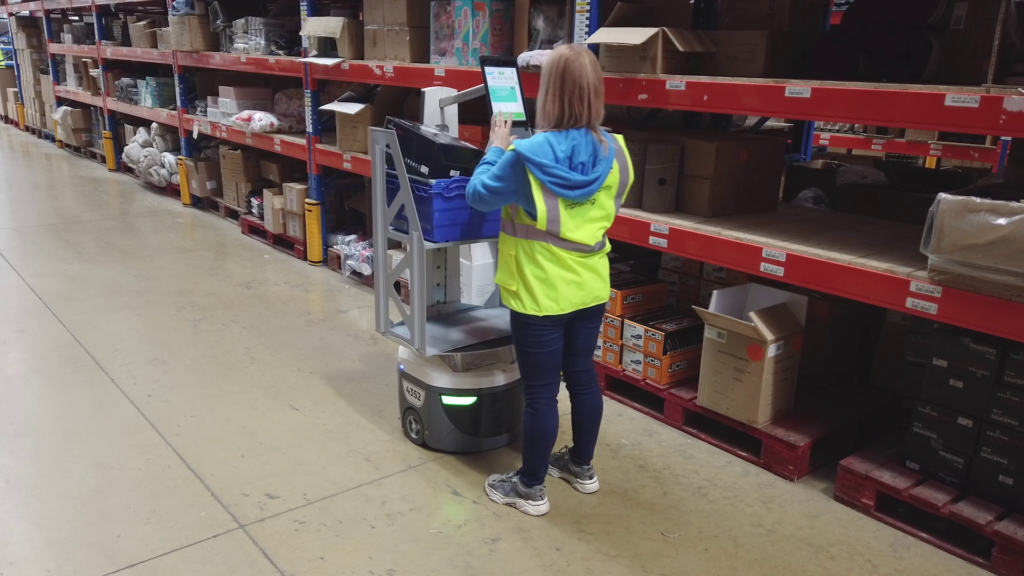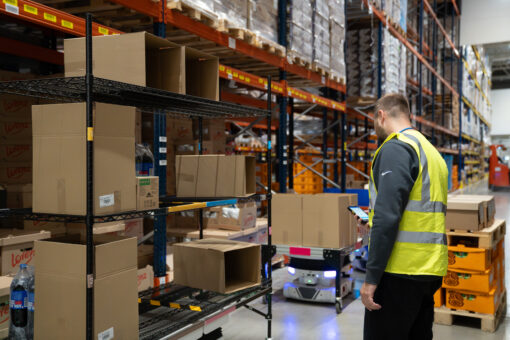WP: How to achieve 400 UPH with Locus Fast Pick
WP: How to achieve 400 UPH with Locus Fast Pick Download Now!
What Are Warehouse Robots and How Can They Help Your Warehouse?
Mary Hart, Sr. Content Marketing Manager

Warehouse, supply chain, and fulfillment center managers deal with multiple headaches on a daily basis — rising order volumes, lowering numbers of people to hire, demands for next-day delivery, budget constraints, and the inability to move to a new facility to gain more space. Meeting customer expectations with conventional and inflexible manual processes is nearly impossible. Pass the Tylenol! Yet many managers hesitate to pursue automation, unsure of the right technologies or how they will impact longstanding workflows that may not be optimal, but they work and you’re used to them.
Let’s demystify one powerful solution that could take your warehouse from “it works” to “this makes my life easier!” — warehouse robots. These mechanical workers optimize your human operations and work alongside your associates rather than replacing people. By understanding their capabilities and implementation best practices, you’ll be able to confidently talk with your own manager and higher-ups about the reasons why robots are a must-have instead of a nice to have for your warehouse.
Defining Warehouse Robots
When we say “robot”, you may picture a clunky mechanical contraption from old sci-fi films. Who else remembers “Klaatu barada nikto” from that old film, “The Day the Earth Stood Still”? I do because my dad is a huge fan of that movie and that phrase was repeated often in our household. Unlike that film, however, our robots aren’t named Gort, nor are they aliens. Instead, the robots in both brownfield and greenfield warehouses are sleek, nimble, intelligent machines that were built to assist human workers. Robots act as the perfect complements — not replacements — for your warehouse employees.
Two major categories exist for warehouse automation:
- Fixed automation, which can include goods-to-person (G2P) refers to conveyors, shuttle systems, and the like that bring the material/goods to the person doing the picking or packing.
- Person-to-goods (P2G) typically refers to autonomous mobile robots (AMRs) that take the goods from the person doing the picking or putaway.
Before you decide on a P2G or any automation solution, you should consider your unique warehouse requirements and select the right option to suit their particular needs.
What Warehouse Robots Do
Modern warehouse robots offer a diverse range of use cases to optimize your warehouse operations:
- Picking: Humans can pick items and place them on robots, which then transport the items to streamline order fulfillment processes. This increases accuracy and throughput and reduces unproductive walking time for your associates.
- Putaway: Robots efficiently move incoming inventory from docks to storage locations, reducing repetitive walking for workers.
- Loading/unloading: Robotic arms rapidly transfer cases, pallets, and containers between docks and conveyors, boosting intake and dispatch speeds.
- Returns processing: Automated inspection, sorting and transport of returns accelerates turnaround time.
- Package routing:-Beyond static conveyors, mobile robots enable flexible routing of completed orders to shipping zones.
Working together in an orchestrated manner, warehouse robots eliminate bottlenecks, minimize errors, and maximize human associate productivity across workflows.
Reasons to Adopt Warehouse Robots
Even if you just automate one process in your warehouse with warehouse robots, you’ll realize measurable gains:
- 2-3x increase in worker productivity
- 50-70% reduction in training time for new hires
- Up to 50% less walking required by employees
- 30%+ increase in picking density within existing footprints
- 99.9% accuracy in inventory and order fulfillment
- Faster ROI than fixed automation like conveyors
Furthermore, robots optimize workflows without disrupting your warehouse’s culture. Instead, they add to your culture by improving employee morale and retention. Adjusting business processes is minimal. And seamless integrations with existing warehouse management systems and equipment keeps implementation risk-free and fast.
Preparing Your Warehouse for Robots
To ensure smooth adoption, address two key areas upfront:
- Employee training: Hands-on exposure to the robots will help associates get used to them and see that the robots make their jobs easier and are safe. You should also implement a clear communication plan and training to emphasize that warehouse robots assist rather than replace your associates.
- Warehouse preparation: For LocusBots, you don’t have to make any big changes to your warehouse nor do you have to close down your operation. Instead, any changes are minor like setting a place for charging stations.
With this preparation in place, your human associates and their new robot coworkers can collaborate well right out of the gate.
Robots are Right for Your Warehouse
Embracing warehouse robots isn’t about tossing out “what works” — it’s about taking what works and enhancing it to be even better with powerful, flexible, adaptable, and scalable robotic partners in productivity, especially when you go with LocusBots. By fine-tuning your strategy — and having one in the first place — integrating robots into your workflow can be as smooth as the movements of the robots gliding through your warehouse merrily carrying orders.
When you take a mindful approach to implementation and commit to harmonizing your human and robotic associates, your warehouse will be primed for improved productivity and reduced cycle time.
Ready to introduce your associates to new robotic coworkers? Talk to us.




